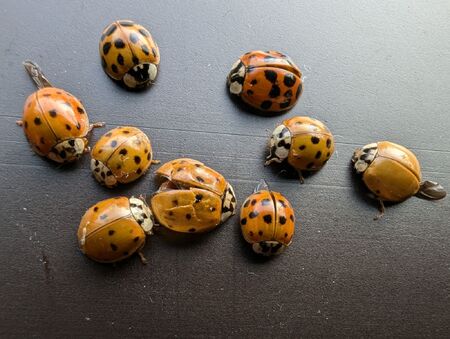
Good Natured: Lady Bugs
Just in case you hadn't noticed… The bugs are back in town.
Make that the ladybugs. Or, to be more correct, the multicolored Asian lady beetles, Harmonia axyridis. Pretty from a distance, yet teeming in numbers, stinky when disturbed and sometimes bitey, these imported insects ain't no ladies. Or are they?
Perhaps ill-mannered by our human standards, the multicolored Asian lady beetle's habits actually do make sense when taken in context. Their peculiar smell is related to a defense behavior called reflex bleeding; they release a small amount of fragrant fluid (toxic alkaloids) to deter predators. And their “bites" aren't meant to be aggressive; they're simply one way an MALB explores its environment. Lastly, their great numbers can be attributed to their reputation as a beneficial insect; in both their larval and adult stages, these insects consume large quantities of garden and crop pests.
Although various isolated introductions occurred in the late 1800s, the imported insect's “official" history here in the United States dates to 1916, when the federal government released a shipment of beetles in California as part of an effort to control aphids and scale insects on nut trees. Subsequent releases around the country, combined with assorted accidental introductions, have led to one undeniable fact: MALBs are here to stay.
If you're reading this near a sunny window ledge, you probably don't need me to tell you that.
According to Asian entomologists, MALBs are programmed to migrate toward “prominent, isolated objects on the horizon" as temperatures cool in the fall. (Our native species head for the safety of loose bark and leaf litter.)
In the MALB's homeland, those “prominent, isolated objects" typically are mountains and cliffs lined with cracks and crevices – excellent places to crawl in and take a long winter's nap. But here, our “prominent, isolated objects" are houses, apartments and offices buildings. And, unless you're really good with a caulk gun, your “object" probably has at least a few cracks and crevices, especially around doors and windows. You may have found you have more than a few multicolored visitors on your windows, curtains and walls.
Why have so many shown up lately? According to research conducted in Ohio, MALB migration as a rule begins the first day temperatures surpass 64F after a period of cooler, near-freezing temps. Our thermometers dipped to around freezing in mid-October, then rose to record highs near the end of the month. That one-two combo put the ladies on the move, into our Hickory Knolls Discover Center as well as many homes throughout the area.
Their presence has given me a great chance to explore the species in great depth. Here's what I've been able to glean over the past couple of weeks:
- Multicolored Asian lady beetles really do come in a multitude of colors. We have yellow ones, orange ones, red ones; some with many spots, some with none at all.
- The one trait they do share is the marking on the pronotum—the small shield-like structure that partially covers the head and thorax. It's conveniently marked with an “M," which makes for a quick way to distinguish MALBs from some of our native ladies.
- Grass spiders are not interested in eating them.
This last observation came last week, when I thought I'd see if a grass spider living in an impressive web in my garage might be interested in a lady beetle meal. I dropped the insect into the spider's web, and waited. Spider Woman (yes, I checked; she's clearly female) scuttled out of her lair and headed toward the ladybug (which may or may not be female, since I'm not sure how to tell). But then, a few millimeters away from her quarry, the spider stopped. After a moment or two, she turned around and headed back to her tunnel at one end of the web. The MALB, meanwhile, walked across the non-sticky silk and onto the floor, none the worse for his or her close encounter.
So, spiders-as-agents-of-MALB-control might not be a sound plan. But indoor humidity and vacuums are. Unless they can find a stable source of humidity, insects that come indoors for winter generally desiccate quickly. Once that happens you can move on to step two, the vacuuming up the dried remains. (Pro tip for next year: Seal gaps around doors and windows to prevent the ladies from coming in at all.)
Are you, like me, wondering what MALB's effects on native ladybug species have been? It would appear that the diversity among our natives is decreasing. But research is ongoing, since it takes time to identify long-term trends.
One worthy effort is Cornell University's Lost Ladybug Project, which relies on data submitted by citizen scientists around the country to track and monitor populations of native ladybug species.
Do you think this program sounds like fun? Get involved! Visit their site, www.lostladybug.org, for more info. Come next spring, you can let them know when the bugs—the native ones, that is—are back in town.
Pam Otto is the outreach ambassador for the St. Charles Park District. She can be reached at potto@stcparks.org.

